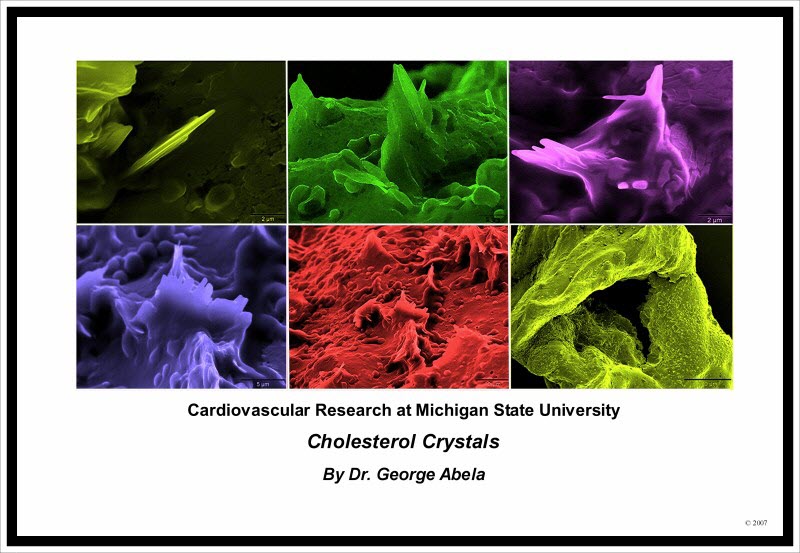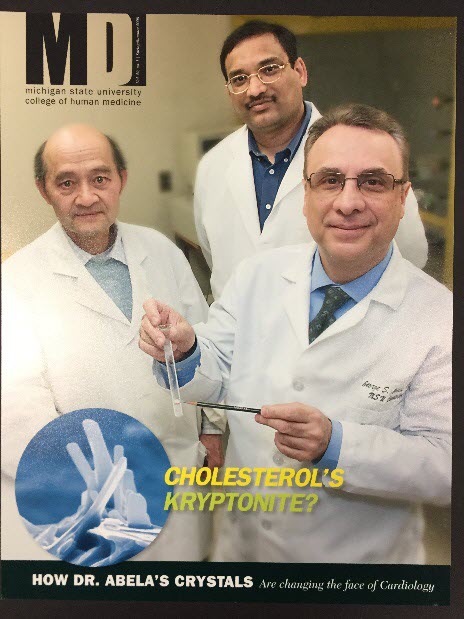Research Reveals Impact of Cholesterol Crystals in Heart Attacks
At Michigan State University’s Department of Medicine, Chief Cardiologist
Dr. George Abela has made life-changing discoveries in understanding the role of cholesterol crystals in heart attacks. His use of unique fixation techniques and scanning electron microscopy have aided his research, revealing that the crystals form from fat, calcium, and other substances that expand in volume when going from a liquid to a solid state.
 Research Reveals Impact of Cholesterol Crystals in Heart AttacksCategory
Research Reveals Impact of Cholesterol Crystals in Heart AttacksCategoryLorem ipsum dolor sit amet, consectetur adipiscing elit.
 Research Reveals Impact of Cholesterol Crystals in Heart AttacksCategory
Research Reveals Impact of Cholesterol Crystals in Heart AttacksCategoryLorem ipsum dolor sit amet, consectetur adipiscing elit.
“We know that cholesterol does exist as a liquid or semi liquid, and when it crystalizes it can perforate or rupture the plaque surface. We show that as it perforates the plaque surface it comes out like an iceberg,” he said.
His most recent publication in the
American Journal of Cardiology evaluates the presence of cholesterol crystals during acute myocardial infarction (AMI) and associated myocardial injury, inflammation, and arterial blood flow before and after percutaneous coronary intervention (stenting). It involved examining artery tissue that would normally be sucked out and discarded during surgery from more than 240 emergency room patients who required angioplasty and stents.
Dr. Abela published his first SEM images of cholesterol crystals in Clinical Cardiology in 2005; these were obtained using the SEMs in the
Center for Advanced Microscopy at MSU. Being able to see the crystals represents a breakthrough in sample processing for imaging, for traditional methods dissolved the crystal leaving behind just an imprint.
“The whole process has been missed because of the use of ethanol, something that’s been used since the 1700s. Alcohol will dissolve fat in tissue. We’ve been missing this picture and this process for a long time,” he said. Results from the first human artery Dr. Abela examined were published in 2006 in Scanning.
Instead of using alcohol to fix the tissue, “He developed a unique method of sample processing for the human arterial samples that involves vacuum drying, followed by wicking, and the processing in vapors of osmium tetroxide to stabilize the lipids present,” said Stan Flegler, Director of the Center for Advanced Microscopy and co-author for a paper on this topic. “The samples are then usually viewed in the low vacuum mode. This method preserves the cholesterol crystals and yet allows us to place them in the vacuum of the SEM.” The paper “Role of Cholesterol Crystals in Atherosclerosis Is Unmasked by Altering Tissue Preparation Methods” was published in Microscopy Research and Technique in 2015.
above: Cholesterol crystals from carotid artery plaques obtained from patients who had endarterectomy surgery. They show clearly the extent of cholesterol crystals emerging from the plaque surface.
Dr. Abela said that being able to see the crystals made it possible to see what was happening on the plaque surface. “We measured the size of the crystals and the presence in single and cluster form in which there are a huge amount of crystals superimposed on each other to form larger constructs that could obstruct the artery, reduce the blood flow, and trigger an inflammatory response that is not good during a heart attack, and can damage the muscle further.” In vitro studies have shown cholesterol to expand in volume when crystallizing. With clear understanding of this process, researchers can further explore treatments that dissolve the crystals, thereby reducing heart damage.
Dr. Abela trained in pathology at Emory University and did work on arterial plaque angioplasty using the SEM at the VA hospital in Gainesville, Florida and later at Harvard University.
All images courtesy of Dr. George Abela
Select Publications
- Cholesterol crystal induced arterial inflammation and destabilization of atherosclerotic plaque; European Heart Journal (2016) 37.
- Frequency of Cholesterol Crystals in Culprit Coronary Artery Aspirate During Acute Myocardial Infarction and Their Relation to Inflammation and Myocardial Injury; American Journal of Cardiology.
- Role of Cholesterol Crystals in Atherosclerosis is Unmasked by Altering Tissue Preparation Methods; Microscopy Research and Technique 78:969–974 (2015).